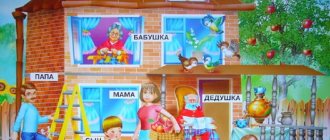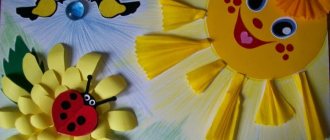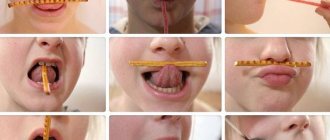Options for individual plans for speech therapy sessions
Options for individual plans for speech therapy sessions
Option 1.
Child's full name:
1. Improving fine motor skills
- Remember the names of the fingers. Master various movements of the fingers. Accompany finger exercises with poetic texts (T. Tkachenko, I. Lopukhina, etc.)
2. Development of auditory attention, auditory perception and auditory memory
- Carrying out various verbal instructions (2-, 3-, 4-step) Guessing an object based on a riddle-description Games with rules (perform an action only under a certain condition): “Request”, “Show”, “It happens, it doesn’t happen” “Pick up a word” ( completing a verse in rhyme), “riddles - tricks” (you need to choose the correct option from the picture, the wrong option rhymes). The child looks at the plot pictures and determines whether each sentence he hears relates to its content.
3. Formation and improvement of phonemic hearing (by, etc.)
- Development of phonemic perception based on the material of correctly pronounced sounds Repetition of a combination of vowel sounds, with their clear articulation Repetition of a chain of syllables with easily pronounced consonant sounds Repetition of a chain of syllables with easily pronounced consonant sounds that are oppositional in terms of voicelessness-deafness Repetition of a chain of syllables with a combination of easily pronounced consonant sounds Incomplete rhymes, rhymes - confusion, rhyming - difficult words Selecting from a number of words one that has a different sound Repeating 3-4 similar-sounding words, pronouncing them clearly
4. Mastering sound analysis and word synthesis 5. Enrichment of vocabulary
- Clarification of lexical topics proposed by Vasilyeva’s “Education and Training in Kindergarten” program, Filicheva’s program words, synonyms, antonyms, parts and wholes, etc.
6. Clarification of the components of grammatical structure
- Development of word formation, inflection, use of prepositions
7. Improving coherent speech
- Description of the picture
- Compiling a story based on a series of plot paintings Retelling the text
8. Improving the functioning of the speech apparatus through mastering articulatory gymnastics
- Mastering basic exercises Performing a set of exercises that help produce a given sound
9. Staging disturbed sounds
- Explanation of sound articulation Showing sound articulation Staging by imitation Staging using probes
10. Automation of delivered sounds
- Isolated In syllables (forward, backward, combinations) In words In phrases In sentences, tongue twisters In poetic texts In spontaneous speech
11. Differentiation with sounds similar in acoustic or articulatory characteristics
Option 2
Child's full name
1. Phonetic side of speech.
- work on sound pronunciation - clarifying the pronunciation of simple consonants and vowels, staging, automation of vibrants. Differentiation of sonorous sounds. Articulation gymnastics Formation of a targeted and strong air stream. Working on your voice power.
2. Lexica.
- Clarification and expansion of the dictionary according to thematic plan. Clarification of the names of geometric shapes. Clarification of the names of colors and shades. Expansion of the predicative dictionary. Expanding the dictionary of features. Studying antonyms.
3. The grammatical structure of speech.
- Formation of verbs - antonyms. Formation of possessive adjectives. Work on understanding and using simple prepositions. Work on agreeing nouns with adjectives. Work on the correct agreement of nouns with pronouns. Work on correct agreement of nouns with verbs. Work on the correct agreement of nouns with numerals. Work on the formation of the plural of nouns in the nominative and genitive cases. Formation of relative adjectives. Formation of singular and plural nouns in the dative and prepositional cases. Studying exception words in plural formation. Formation of diminutive and augmentative forms of nouns. Formation of diminutive forms of adjectives. Work on understanding and using complex prepositions.
4. Phonemic side of speech.
- differentiation of sounds by deafness-voiceness, development of auditory attention based on the material of non-speech sounds. Isolating vowel sounds among a number of vowels. Isolating consonant sounds among a number of consonants Isolating the first stressed vowel in a word. Emphasis on the first consonant in a strong position. Phonemic analysis of two- and three-syllable constructions.
5. Coherent speech.
- Compiling a story - a description based on a visual example. Compiling a story based on a plot picture. Compose a story based on your own experience. Compiling stories based on simple and complex series of plot pictures. Retelling fairy tales and simple texts Memorizing poems, tongue twisters, riddles
6. Development of HMF and motor skills.
- development of voluntary memorization, increase in the volume of auditory-verbal memory, development of all types of perception, development of auditory attention, development of fine and facial motor skills, development of kinesthetic perception, development of spatial concepts, development of imagination, development of visual and constructive activities, development of logical thinking.
Option 3 (a + sign is placed opposite the required item)
Planning individual speech therapy work with ________________________________
1. Formation of correct sound pronunciation.
- Speech therapy massage; develop the mobility of the articulatory apparatus; setting and correction of sounds: group of whistling sounds – S, Sь, З, Зь, Ц; group of hissing sounds – Ш, Ж, Х, Ш; group of sonorous sounds – L, Ль, Р, Рь labio-labials – P, B, M + soft. labiodental – T, D, N + soft. posterior lingual – K, G, X + soft. Others __________________________ automate sounds in syllables, words, sentences, connected text.
2. Formation of phonemic perception:
- identify sounds (vowels, consonants, hard-soft, voiceless-voiced); determine the presence and absence of a sound, the place of a sound in a word.
3. Formation of phonemic hearing 4. Work on the syllabic structure of the word. 5. Development of grammatical structure of speech
- word formation; inflection.
6. Development of the lexical side of speech
- expand subject vocabulary; expand the dictionary of features; expand your verb vocabulary.
7. Formation of coherent speech
- develop the ability to write a story based on a picture; develop the ability to compose a story based on a series of paintings; develop the ability to compose a retelling; develop the ability to compose a story - description.
8. Development of mental processes, motor skills, intellectual activity:
- develop visual attention, memory, perception, thinking; develop fine and articulatory motor skills.
Get text
December, January, February (2nd period of study)
Lexical topics: “Clothes”, “Shoes”, “Winter”, “New Year”, “Winter fun”, “Winter clothes”, “Wild animals”.
Corrective tasks:
a) Formation of vocabulary and grammatical structure of speech:
• continue to form and consolidate previously studied grammatical categories;
• develop an understanding and practical use of singular forms of nouns in the genitive and accusative cases with prepositions and in the prepositional case;
• to form an understanding and practical mastery of the prepositions U, NA, V, IZ.
b) Development of coherent speech:
• continue to develop and strengthen the skills of writing sentences and simple descriptive stories;
• teach the skills of retelling stories and fairy tales “The Three Bears”, “Kolobok” using questions and a picture plan;
• continue to develop dialogical speech skills in the process of developing communication in preschoolers.
c) Development of cognitive processes:
• color (blue);
• continue the work started in the first period;
• form a serial series “big, smaller, small”, “small, bigger, big”;
• form temporary ideas (winter).
d) Formation of phonemic perception and sound pronunciation:
• continue the work started in the first period;
• introduce the sounds “I”, “O”, “E”;
• learn to perceive by ear and correctly reproduce the simple syllabic structure of words.
How to create an individual study plan
It is compiled by school employees. The main principle in compilation is to include in it items that are mandatory for the general education school curriculum. At certification, a child who has studied under the IUP goes through the same tests as his peers, without any concessions or special conditions.
Mandatory points of the IUP:
- the IUP includes all compulsory subjects at the basic level;
- include additional items at the basic level;
- include a regional component - those subjects that are required to be studied in specific regions of the Russian Federation (region, republic);
- take into account the requirements for students adopted at the school in which the student is transferred to the IEP.
General algorithm for making a curriculum:
- Talk with the student and his parents, find out all the features, the purpose of the transfer, the needs of the student.
- Determine the child’s level of knowledge, what he has learned, what he can do.
- Study the basic curriculum. The federal basic curriculum and exemplary curricula are in the appendix to the Order of the Ministry of Education of the Russian Federation dated 03/09/2004 No. 1312 “On approval of the federal basic curriculum and exemplary curricula for educational institutions of the Russian Federation implementing general education programs.”
- Study the school's educational program.
- Compile an IEP based on these data.
Sample of a student's individual educational plan
Features when eliminating academic debt
The transition to the IEP is an opportunity not to leave the child for the second year, but to conditionally transfer him to the next grade. In this case, an individual curriculum for academic debt is drawn up so that the student improves in problematic subjects, passes the debt and continues his studies.
What are the features of IEP
The main task is to provide the child with an education taking into account his characteristics, choosing the optimal level of educational programs for him, the pace and timing of training. With the IEP, it is allowed to change the list of subjects, the depth of their study, and the sequence of studying subjects during the academic year. But there is an important limitation: the procedure for organizing training according to an individual curriculum should not go beyond the federal state educational standards of general education (FSES).
Peculiarities:
- Ability to change the complexity of training. It is allowed to reduce or increase the hourly load. If a subject is taught at a basic level at school, a student in the IUP is allowed to study at an advanced level in that subject. For example, study mathematics in depth at a school with a humanitarian focus. If at school a subject is studied at an in-depth level, the student at the IEP is allowed to be given material at the basic level. For example, in a school with a mathematical bias, study geometry and algebra at a basic level.
- Ability to change the sequence of study. If a school provides instruction in all subjects at once, a student using an individual plan is allowed to study subjects sequentially, in the form of blocks or modules. For example, first study the entire chemistry course, then the entire physics course, then the Russian language course. It is allowed to combine sequential and parallel study, when one or more subjects are taught weekly during the year, and the rest are studied in blocks.
- Ability to change the list of items. It is allowed to add or remove subjects to the curriculum if this does not contradict the Federal State Educational Standard.





![Summary of a lesson on speech development for children 4–5 years old “Sound culture of speech: letter [p]”](https://mybabby.ru/wp-content/uploads/konspekt-zanyatiya-po-razvitiyu-rechi-dlya-detej-4-5-let-330x140.jpg)
